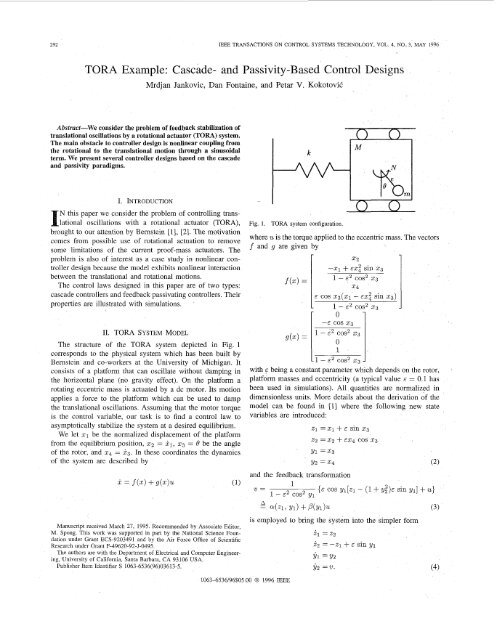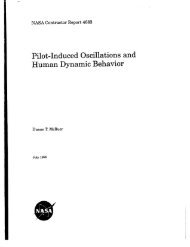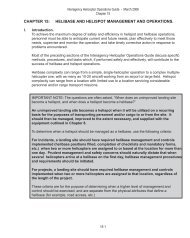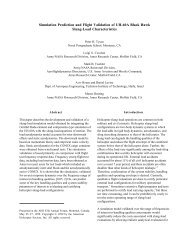TORA Example: Cascade- and Passivity-Based Control Designs ...
TORA Example: Cascade- and Passivity-Based Control Designs ...
TORA Example: Cascade- and Passivity-Based Control Designs ...
You also want an ePaper? Increase the reach of your titles
YUMPU automatically turns print PDFs into web optimized ePapers that Google loves.
292 IEEE TRANSACTIONS ON CONTROL SYSTEMS TECHNOLOGY, VOL. 4, NO. 3, MAY 1996<br />
A <strong>Example</strong>: <strong>Cascade</strong>- <strong>and</strong> <strong>Passivity</strong>-<strong>Based</strong> <strong>Control</strong> <strong>Designs</strong><br />
Abstract-We consider the problem of feedback stabilization of<br />
translational oscillations by a rotational actuator (<strong>TORA</strong>) system.<br />
The main obstacle to controller design is nonlinear coupling from<br />
the rotational to the translational motion through a sinusoidal<br />
term. We present several controller designs based on the cascade<br />
<strong>and</strong> passivity paradigms.<br />
Mrdjan Jankovic, Dan Fontaine, <strong>and</strong> Petar V. KokotoviC<br />
I. INTRODUCTION<br />
N this paper we consider the problem of controlling trans-<br />
lational oscillations with a rotational actuator (<strong>TORA</strong>),<br />
brought to our attention by Bernstein [1], [2]. The motivation<br />
comes from possible use of rotational actuation to remove<br />
some limitations of the current proof-mass actuators. The<br />
problem is also of interest as a case study in nonlinear con-<br />
troller design because the model exhibits nonlinear interaction<br />
between the translational <strong>and</strong> rotational motions.<br />
The control laws designed in this paper are of two types:<br />
cascade controllers <strong>and</strong> feedback passivating controllers. Their<br />
properties are illustrated with simulations.<br />
11. <strong>TORA</strong> SYSTEM MODEL<br />
The structure of the <strong>TORA</strong> system depicted in Fig. 1<br />
corresponds to the physical system which has been built by<br />
Bernstein <strong>and</strong> co-workers at the University of Michigan. It<br />
consists of a platform that can oscillate without damping in<br />
the horizontal plane (no gravity effect). On the platform a<br />
rotating eccentric mass is actuated by a dc motor. Its motion<br />
applies a force to the platform which can be used to damp<br />
the translational oscillations. Assuming that the motor torque<br />
is the control variable, our task is to find a control law to<br />
asymptotically stabilize the system at a desired equilibrium.<br />
We let 21 be the normalized displacement of the platform<br />
from the equilibrium position, 22 = &I, 23 = 0 be the angle<br />
of the rotor, <strong>and</strong> 24 = 23. In these coordinates the dynamics<br />
of the system are described by<br />
Manuscript received March 27, 1995 Recommended by Associate Editor,<br />
M Spong This work was supported in part by the National Science Foun-<br />
dation under Grant ECS-9203491 <strong>and</strong> by the Air Force Office of Scientific<br />
Research under Grant F-49620-92-J-0495<br />
The authors are with the Department of Electrical <strong>and</strong> Computer Engineer-<br />
ing, University of California, Santa Barbara, CA 93106 USA<br />
Publisher Item Identifier S 1063-6536(96)03613-5<br />
1063-6536/96$05.00 0 1996 IEEE<br />
Fig. 1. ToRA system configuration.<br />
where U is the torque applied to the eccentric mass. The vectors<br />
f <strong>and</strong> g are given by<br />
I -51<br />
1 -E cos<br />
O X? l<br />
1 - E2 cos2 53<br />
dxc) =<br />
0<br />
1<br />
11 - E2 cos2 53 1<br />
with E being a constant parameter which depends on the rotor,<br />
platform masses <strong>and</strong> eccentricity (a typical value E = 0.1 has<br />
been used in simulations). All quantities are normalized in<br />
dimensionless units. More details about the derivation of the<br />
model can be found in [1] where the following new state<br />
variables are introduced:<br />
52<br />
+ EX; sin 23 1 - E2 cos2 53<br />
54<br />
z1 = 21 + E sin 2 3<br />
z2 = 5 2 + EX4 cos 23<br />
Y1 =53<br />
Y2 =54<br />
<strong>and</strong> the feedback transformation<br />
a<br />
= 421, Y1) + P(Yl)U<br />
is employed to bring the system into the simpler form<br />
Zl =z2<br />
Zz = -21 + E sin y1<br />
1<br />
(3)<br />
Yl =y2<br />
y, ='U (4)
IEEE TRANSACTIONS ON CONTROL SYSTEMS TECHNOLOGY, VOL. 4, NO. 3, MAY 1996<br />
Because E is always smaller than one, the transformation from<br />
U to w is nonsingular.<br />
111. CASCADE SYSTEM DESIGNS<br />
stable. One such control law is y1 = - arctan (~0.~2)<br />
Recognizing that y1 is not the control variable, <strong>and</strong> that the<br />
deviation from its desired value is
294<br />
-1<br />
I v. I<br />
0 5 1 0 1 5 2 0 2 5 3 0 3 5 4 0 4 5 5 0<br />
Normelizod Pmsltw<br />
41 I<br />
Normalized Torque<br />
Fig. 2. Transient behavior with (Cl) <strong>and</strong> (C2) control laws.<br />
In other words, for some choices of the parameters, the two<br />
control laws would result in the same performance.<br />
Indeed, simulations have shown that the two control laws<br />
are similar even beyond the limiting case. In Fig. 2 the plots'<br />
of translational displacement x1 <strong>and</strong> the control effort U with<br />
(C1) (solid curve, S = 0) <strong>and</strong> with (C2) (dashed curve, 6 =<br />
10) show a slight improvement with the backstepping method.<br />
For a clearer illustration of some properties of the backstep-<br />
ping control we consider the following example:<br />
x = -x + g(x)y<br />
y =u.<br />
Since with y G 0 the z-subsystem is globally asymptotically<br />
stable, in the second step of backstepping we let the Lyapunov<br />
function be<br />
Po 2 Pl 2<br />
v=--2 +-y.<br />
2 2<br />
Its derivative along the trajectories of (8) is<br />
V = -Pox2 + Poxg(z)Y + PlYU<br />
<strong>and</strong> a choice of U which makes V negative definite is<br />
PO<br />
U = -- xg(x) - ay.<br />
P1<br />
With this backstepping control the resulting closed-loop sys-<br />
tem is<br />
This system has the form of a damped nonlinear oscillator. In<br />
contrast, a (C1)-type controller for (8) is simply U = -ay <strong>and</strong><br />
results in the closed-loop system which is upper triangular.<br />
Some of the benefits of the term -(po/pl) g(x) introduced by<br />
backstepping are:<br />
1) If, for example, g(x) = x2 a (Cl)-type controller cannot<br />
guarantee global stability. This advantage is not present<br />
in the <strong>TORA</strong> system which is globally Lipschitz.<br />
'All our plots show 51 <strong>and</strong> U. To compare them with [l] <strong>and</strong> [2] the values<br />
shown should be divided by 10<br />
IEEE TRANSACTIONS ON CONTROL SYSTEMS TECHNOLOGY, VOL. 4, NO. 3, MAY 1996<br />
2) When g(z) is globally Lipschitz, or even constant, say<br />
g(z) = go, then -(po/pl)g(z) improves the transient<br />
by reducing the overshoot of x due to an initial condition<br />
of y. If (po/p1) is very small the overshoot is large <strong>and</strong>,<br />
vice-versa, if (po/pl) is large the overshoot is small.<br />
For the <strong>TORA</strong> problem this improvement is negligible<br />
because the connection between the two subsystems is<br />
weak (E = 0.1).<br />
IV. FEEDBACK PASSIVATING DESIGNS<br />
The cascade designs in Section I11 resulted in complicated<br />
control laws that require full state feedback <strong>and</strong> cancellation<br />
of nonlinearities. Our more ambitious design objective is to<br />
use a reduced set of measurements <strong>and</strong> avoid cancellation of<br />
nonlinearities. This will simplify instrumentation <strong>and</strong> improve<br />
robustness.<br />
A design paradigm which can be used to accomplish this<br />
objective is feedback passivation [6]. We design three passi-<br />
vating controllers: (Pl), (P2), <strong>and</strong> (P3). Our basic passivating<br />
feedback controller (Pl) employs a reduced number of states<br />
(zl, y1, y2), but still cancels two nonlinear terms. To avoid<br />
cancellation, we refine the storage function <strong>and</strong> design the<br />
(P2) controller which has a surprisingly simple form U =<br />
-klyl - k2y2 aad accomplishes our design objective. To<br />
increase the damping of x1 beyond a limit imposed by the<br />
simple structure of (P2), we employ a storage function with<br />
increased penalty on z1 <strong>and</strong> 22. The resulting passivating<br />
controller (P3) achieves improved damping of 21. It matches<br />
the damping obtained with the cascade control laws, but with<br />
smaller control effort.<br />
We rewrite the <strong>TORA</strong> system in the (2, y)-coordinates with<br />
the original input U<br />
z1 =22<br />
22 = -21 + E sin y1<br />
$1 =y2<br />
$2 = 421, Y1) + P(Yl)U (9)<br />
with QI <strong>and</strong> p defined in (2).<br />
(PI) <strong>Control</strong>ler-Feedback Passivation: The (P1)-design<br />
illustrates the feedback passivation procedureJ Its basis is the<br />
requirement that, for a system to be passive from an input U<br />
to an output y = h(x), the relative degree one <strong>and</strong> weakly<br />
minimum phase conditions must be satisfied.<br />
Choice of the Output Function: For the system (9) the constraint<br />
of relative degree one means that the output h(z, y)<br />
must be a function of y~. So, we let h(z, y) = y ~. With this<br />
output the corresponding zero dynamics subsystem<br />
2.2 = -21 + E sin y1<br />
y, =o (10)<br />
is stable by inspection. This means that the system (9) with<br />
the output y = y2 is weakly minimum phase.
IEEE TRANSACTIONS ON CONTROL SYSTEMS TECHNOLOGY, VOL. 4, NO. 3, MAY 1996 295<br />
Lyapunov Function for the Zero Dynamics: In this step we<br />
want to find a Lyapunov function U(z, yl) for (9) which will<br />
be incorporated into the passivating feedback law. Because y1<br />
is constant, we can treat (10) as a linear system <strong>and</strong> select<br />
+ - 22” + - y1<br />
1 1<br />
U(Z, y1) = - (21 - E sin ~ 1 ) ~ k1 (11)<br />
2 2 2<br />
with kl being a design parameter. The time derivative of U<br />
along the trajectories of the system (10) is nonpositive, in fact<br />
U = 0, which is satisfactory, since (10) is not asymptotically<br />
stable.<br />
Passivating Feedback <strong>and</strong> Storage Function: Note that the<br />
system (9) is already in the normal form as defined in [6].<br />
Therefore, the feedback transformation<br />
2 2<br />
= E y2 sin y1 cos y1 - cos2 yl(z1 - E sin yl)<br />
- (1 - E2 cos2 y1)(k1y1 - u1) (12)<br />
renders the system passive from the input u1 to the output y2<br />
with respect to the storage function<br />
-<br />
1 1 k l 2 1 2<br />
W(z, y) = - (21 - E sin y~)’ + - 22” + -yl + - y2. (13)<br />
2 2 2 2<br />
Indeed, E = y2ul which means that the system (9), (12) is<br />
not only passive, but also lossless (see [6] <strong>and</strong> [7]).<br />
A fundamental passivity property [8], [9] is that the feed-<br />
back connection of a passive <strong>and</strong> a strictly passive block is<br />
stable in the sense that y2 E L2. Therefore, we can select<br />
any strictly passive feedback control law. The simplest one<br />
is u1 = -k2y2 with which we complete our (Pl) controller<br />
design. Returning to the original control U, (P1) controller is<br />
2 2 3 2<br />
U =E y2 sin y1 cos y1 - E cos yl(z1 - E sin y1)<br />
- (1 - E2 cos2 Yl)(klYl + k2Y2). (PI)<br />
Its passivity property guarantees only stability. Additional<br />
properties are needed to conclude asymptotic stability.<br />
(P2) <strong>Control</strong>ler-Passivation without Cancellation: Even<br />
though it is simpler than (Cl) or (C2), the controller (Pl) has<br />
not completely satisfied the design objective because it uses<br />
three states for feedback <strong>and</strong> cancels nonlinearities. We now<br />
show that, by modifying the storage function (13) as<br />
1 1 2 h 2<br />
~ ( z y) , = - (21 - E sin ~ 1 + ) - z2 ~ + - y1<br />
2 2 2<br />
y;(1 - E2 cos2 y1) (14)<br />
+ ;<br />
we can achieve the desired objective. The passivating feedback<br />
transformation with respect to W is U = -klyl + u1.<br />
This simple feedback achieves passivity from u1 to yy~ since<br />
I/t’(z, Y) = YZUl.<br />
The next step is to achieve global asymptotic stability.<br />
We close the feedback loop with the simplest strictly passive<br />
block: u1 = -k2y2. Thus our (P2) controller is<br />
U = -k1y1 - k2y2.<br />
(P2)<br />
With the control law (P2) we have = -k2y$ 5 0 which<br />
implies that the origin of the closed-loop system (9), (P2) is<br />
05<br />
= l o<br />
0 5 1 0 1 5 2 0 2 5 3 0 3 5 4 0 4 J M<br />
Nwm(rl/zed b mon<br />
-0.5<br />
0 5 1 0 1 5 2 0 2 5 3 0 3 5 4 0 4 5 5 0<br />
Normdized Torque<br />
Fig. 3. Response of the (P2)-system<br />
stable in the sense of Lyapunov <strong>and</strong> all the states are bounded.<br />
Because W is radially unbounded these properties are global.<br />
Now we employ LaSalle’s invariance principle to prove<br />
asymptotic stability. The largest invariant set of the closedloop<br />
system (9), (P2) contained in the set R = ((2, y) E<br />
R4: y2 = 0}, where = 0, is determined from y2 0, i.e.,<br />
0 E cos yl(x1 - E sin y1) - klyl.<br />
(15)<br />
Because ~1 = y2 = 0, yl = const. Then it follows from (15)<br />
that z1 = const =+ 22 0 j 22 = z1 - E sin y1 G 0. So the<br />
only solution of (15) inside the set 0 is z1 = y1 = 0 which<br />
proves the global asymptotic stability of z1 = z2 = y1 = y2 =<br />
0.<br />
A typical response of the (P2)-system is shown in Fig. 3<br />
with ICl = 1, k2 = 0.14 chosen for the fastest possible<br />
convergence.<br />
We remark that (P2) controller is a linear version of the<br />
“passive absorber” proposed in [2]. <strong>and</strong> the plots in Fig. 3<br />
closely resemble those obtained in [2].<br />
The (P2) controller achieves our design objectives because it<br />
does not cancel nonlinearities <strong>and</strong> uses only the rotor variables<br />
y1 <strong>and</strong> y2 for feedback. The simulations show that its control<br />
effort is smaller than with (Cl) <strong>and</strong> (C2). A drawback of<br />
(P2), however, is that the speed of convergence of x1 to zero<br />
cannot be increased by adjusting the gains. This problem will<br />
be resolved by our (P3) controller in the next section. But first<br />
we illustrate some of the possibilities of achieving different<br />
control objectives with simple (P2)-type control laws.<br />
(P2) with Bounded <strong>Control</strong>: Here we design a control law<br />
which achieves global asymptotic stabilization with the norm<br />
of the input never exceeding some prescribed value 6 > 0.<br />
One such control law is<br />
with k1 < 6. The magnitude of the input Ub is obviously<br />
bounded by 6 <strong>and</strong> global asymptotic stability follows from the<br />
Lyapunov function
296 IEEE TRANSACTIONS ON CONTROL SYSTEMS TECHNOLOGY, VOL. 4, NO. 3, MAY 1996<br />
'-it<br />
0.5<br />
-1 -5 I 15 2 1<br />
-52 -15 -1 -05 0 05 1<br />
Reel Axis<br />
Fig. 4. Root locus for s2 + bs + a as b varies from 0-00.<br />
Note that we have substituted the quadratic term by a term with<br />
linear growth at infinity. Nevertheless, Wb is positive definite,<br />
radially unbounded <strong>and</strong> Wb = -(S - k1)y~ arctan y2 5 0.<br />
Again, by LaSalle' s invariance principle, the origin is globally<br />
asymptotically stable.<br />
(P2) with Prespec$ed Equilibrium Structure: We may<br />
want to preserve the existing equilibria or to create a set<br />
of new ones (for example, to prevent unwinding). As an<br />
illustration we use the feedback to create the set of equilibria<br />
at (0, 0, 2kn, 0) with k = 0, fl, f2, .... These equilibria<br />
will necessarily be alternatively stable <strong>and</strong> unstable. This<br />
objective is achieved by the bounded control<br />
U, = -IC1 sin (0.5~1) - kz arctan yz. (18)<br />
The Lyapunov function is<br />
IC1 2<br />
W, = W - - y1 + 4kl sin2 (0.25~~)<br />
2<br />
(19)<br />
<strong>and</strong> the invariant set is given by (0, 0, 2kn, 0). It can be<br />
shown that the states converge to one of these equilibria which<br />
represent the same point in physical space.<br />
(P3) <strong>Control</strong>ler-Transient Performance: It has already<br />
been pointed out that the (P2) controller cannot decrease<br />
the settling time of z1 beyond a limit. To explain the reasons<br />
for this limitation <strong>and</strong> to motivate our approach to overcome<br />
it, we consider the following simple linear system:<br />
This system is passive from the input U to the output y with<br />
respect to the storage function V = (a/2)z2 + iy'. Now<br />
the simplest feedback law which achieves global asymptotic<br />
stability is U = -by which corresponds to the (P2) control for<br />
the system (9).<br />
The root locus for the characteristic equation of the closed-<br />
loop system, as b varies from 0 to 00 <strong>and</strong> a = 1, is given<br />
in Fig. 4.<br />
It shows that the settling time for z cannot be decreased<br />
arbitrarily.<br />
-1<br />
0 5 10 15 20 25 30 35 40 45 50<br />
Normalized Poshon<br />
4: 5 io 1; 20 25 do j, io 4'5 5L<br />
Normalired Torque<br />
Fig. 5. Response with (P3) <strong>and</strong> (C2) controllers<br />
To assign a smaller settling time we have to use the z<br />
variable in the feedback law. In the framework of passivating<br />
designs this can be accomplished by modifying the storage<br />
function to increase the penalty on z. Thus with the storage<br />
function V = (a + c/2)z2 + y2, the resulting control law<br />
U = -ex - by achieves arbitrarily small settling time of z by<br />
increasing b <strong>and</strong> C.<br />
Motivated by the above example we introduce a design<br />
parameter ko to increase the penalty on the z-variables in the<br />
Lyapunov function (14)<br />
ko + 1 kl 2<br />
Wu = ___ [(zl - E sin y1)' + z,2] +<br />
2<br />
+ $ yi(1 - E2 cos2 y1).<br />
The function W, can be made a storage function by the<br />
passivating feedback transformation U = - ~ O E cos yl(-zl +<br />
E. sin y1) - Sly1 SUI. Therefore, our (P3) controller achieving<br />
Wu = < - 0 is given by<br />
U = -he cos yl(-zl + E sin y1) - klyl - kzy2 (~3)<br />
<strong>and</strong> LaSalle's invariance principle again guarantees that the<br />
origin is globally asymptotically stable. Note that when ko =<br />
0 this control law reduces to (P2).<br />
This design modification significantly improves the settling<br />
time, compared with the (P2) controller. By increasing<br />
the parameter ko we can match the performance of<br />
the cascade controllers, but with smaller control effort as<br />
illustrated in Fig. 5. The solid curves represent the (P3) con-<br />
troller with (ko, k ~ k , ~ = ) (10, 1, 0.5) <strong>and</strong> the dashed curves<br />
represent the (C2) controller with (PO, PI, pa, CO, cl, CZ) =<br />
(2, 0.2, 1, 2.3, 0.6, 0.6).<br />
Remark 4.1: Note that the controllers (P2) <strong>and</strong> (P3) guar-<br />
antee global asymptotic stability of the closed-loop system for<br />
any positive values of the gains ko, kl, k ~ Therefore, . if we<br />
multiply the control U by any positive constant, the resulting<br />
control law still achieves global asymptotic stability; in other<br />
words, these controllers have infinite gain margin.<br />
From (2) we have that XI - E sin y1 = 51. Recall that<br />
z1 is the normalized displacement of the platform. If we<br />
\<br />
y1
IEEE TRANSACTIONS ON CONTROL SYSTEMS TECHNOLOGY, VOL. 4, NO. 3, MAY 1996 291<br />
denote by q1 the actual (measured) displacement <strong>and</strong> by 0<br />
the normalizing factor, we can rewrite (P3) as<br />
Thus, even when E <strong>and</strong> 0 are not known (i.e., when the mass<br />
parameters of the system are not known), (P3) achieves global<br />
asymptotic stability.<br />
V. CONCLUSION<br />
In this paper we have considered the problem of asymptotic<br />
stabilization of the <strong>TORA</strong> system. <strong>Based</strong> on two different<br />
paradigms we have designed several controllers which achieve<br />
global asymptotic stability. Performance of these controllers<br />
was compared by simulations. The summary of our findings<br />
is given below:<br />
For the <strong>TORA</strong> system the (C2) controller <strong>and</strong> the much<br />
simpler (Cl) controller give almost the same performance<br />
because the coupling between subsystems is weak.<br />
The (P2) controller uses only 8 <strong>and</strong> 6 for feedback <strong>and</strong><br />
requires the smallest control effort. Its drawback is that<br />
the settling time cannot be decreased beyond a certain<br />
limit.<br />
The (P3) controller allows a faster <strong>and</strong> better damped<br />
response at the expense of increased control effort <strong>and</strong><br />
the addition of a sensor for platform displacement. Still,<br />
the control effort is smaller than with the comparable<br />
cascade controllers.<br />
The design of passivating controllers is not systematic<br />
because it relies on the knowledge of a storage function.<br />
On the other h<strong>and</strong>, the controller design for cascade<br />
systems is systematic.<br />
ACKNOWLEDGMENT<br />
The authors would like to thank D. S. Bernstein for many<br />
useful discussions <strong>and</strong> for bringing this control design problem<br />
to their attention.<br />
REFERENCES<br />
[l] C.-J. Wan, D. S. Bernstein, <strong>and</strong> V. T. Coppola, “Global stabilization<br />
of the oscillating eccentric rotor,” in Proc. 33rd IEEE Con$ Decision<br />
Contr., Dec. 1994, pp. 402444029.<br />
[2] R. T. Bupp, C.-J. Wan, V. T. Cappola, <strong>and</strong> D. S. Bernstein, “Design of<br />
a rotational actuator for global stabilization of translational motion,” in<br />
Proc. Symp. Active Contr. Vibration Noise, ASME Winter Mtg., 1994.<br />
[3] A. Saberi, P. V. KokotoviC, <strong>and</strong> H. J. Sussmann, “Global stabilization of<br />
partially linear composite systems,” SIAM J. Contr. Optimization, vol.<br />
28, no. 6, pp. 1491-1503, 1990.<br />
[4] H. J. Sussmann <strong>and</strong> P. V. KokotoviC, “The peaking phenomenon <strong>and</strong><br />
the global stabilization of nonlinear systems,” IEEE Trans. Automat.<br />
Contr., vol. 36, pp. 4244440, 1991.<br />
[5] H. J. Sussmann, E. D. Sontag, <strong>and</strong> Y. Yang, “A general result on the<br />
stabilization of linear systems using bounded controls,” IEEE Trans.<br />
Automat. Contr., vol. 39, pp. 2411-2425, Dec. 1994.<br />
[6] C. I. Byrnes, A. Isidori, <strong>and</strong> J. C. Willems, “<strong>Passivity</strong>, feedback<br />
equivalence, <strong>and</strong> the global stabilization of minimum phase systems,”<br />
IEEE Trans. Automat. Contr., vol. 36, pp. 1228-1240, Nov. 1991.<br />
171 J. C. Willems, “Dissipative dynamical systems, Part I: General theory,”<br />
Arch. Rational Mech. Anal., vol. 45, pp. 321-351, 1972.<br />
[8] C. A. Desoer <strong>and</strong> M. Vidyasagar, Feedback Systems: Input-Output<br />
Properties. New York: Academic, 1975.<br />
[9] V. M. Popov, Hyperstability of <strong>Control</strong> Systems. New York: Springer-<br />
Verlag, 1973.








